(Before we start, you can find my massive Black Friday 2017 deals post here, expect a massive churn on that post over the next 5 days, as we go through both Black Friday and Cyber Monday. This guide attempts as best as possible to take into account pricing there, though I’ve also made it clear where specific price points may change recommendations.)
Exactly one year later to the day, it’s time for some new winter 2017-2018 sports tech recommendation goodness. Gadgets galore!
My goal here being to give my specific recommendations – exactly the same recommendations I’d give to my own friends and family. This post isn’t here to list every option on the market in an effort to make every manufacturer happy. Of course, as more and more companies get into the market, there ends up being more and more possible scenarios as the products expand in functionality.
Finally, if you use either the Amazon or Clever Training links, you help support the site. I’ve partnered with Clever Training to offer all DC Rainmaker readers exclusive benefits on all products purchased. You can read more about the benefits of this partnership here. You can pick up most devices below through Clever Training using the links in the tables. By doing so, you not only support the site (and all the work I do here) – but you also get to enjoy the significant partnership benefits that are just for DC Rainmaker readers (like saving 10% on non-clearance/deep-sale items). And, if you are picking up items that are more than $75, you can get free US shipping as well.
With that, let’s dive into it!
Running GPS Watches
In 2017 we actually have seen very little new movement in the running-only GPS realm. Instead, what we’ve seen to date is the addition of a plethora of mid-range all-around fitness/sports watches that also do a mid-range job of running. What’s mid-range? Well, it means they can, of course, do things like GPS tracking of where you are, pace, distance, and laps. But most also do basic intervals and sometimes customized downloadable workouts. Whereas in most cases you get more complex recovery and training load features in higher-end features.
Also, we’ve had a bunch of new models in that same mid-range realm in the last 60-90 days that are definitely all-arounders. Things like the Fitbit Ionic, Apple Watch Series 3, Vivoactive 3, and to a far lesser extent, Samsung Gear Sport.
Road Running – Best All Arounder: Garmin Vivoactive 3, Polar M430, Suunto Spartan Trainer Wrist HR
All three of those watches make great running watches, and all released in the last 6 months, and all very close in price (especially with Black Friday sales). All have optical HR in them, and all can do more than just running. There are slight nuances though that are worthwhile pointing out. The Vivoactive 3 has Garmin Pay, which is contactless payments at stores (plus apps on Connect IQ). The Polar M430 meanwhile is a bit less expensive than the other options. At the other end you’ve got the Spartan Trainer Wrist HR, which is a full-blown tri watch capable of displaying running power too.
If you’re looking for the most stylish day to day option, I’d say it’s the sleek Vivoactive 3, while the Spartan Trainer is the most powerful option.
Road Running – Geekful of data: Garmin FR935
You want all the data? Go with the FR935. Why not the Fenix 5 you ask? Well, simply put the FR935 doesn’t have the ANT+ signal connection issues the Fenix 5 does with some 3rd party sensors (notably Stryd’s Running Power Meter). The FR935 not only supports ANT+ & Bluetooth Smart sensors, but also has all the new FirstBeat training load and recovery metrics that were introduced this year to both the Fenix 5 and FR935.
Plus, the FR935 is essentially just a plastic shelled Fenix 5. It’s running the same software at this point – both packed full of everything from advanced metrics to 3rd party app support for even more metrics. Also, it’s what I use for running, in the event that means something. And finally, the FR935 supports Garmin’s running power, slated to go-live in about two weeks.
Running – With Music: Fitbit Ionic, Polar M600, Apple Watch 2/3
This year we’ve seen everyone converge on the $299 price point with music (except Garmin, which missed that memo apparently). Polar was there a while back with the M600 Android Wear option, and then others came in. Some of your decision here will be based around what phone platform you use. With Apple Watch, you’ve gotta be on iOS. With the M600 you can use iOS, but it tends to work better with Android. Fitbit is across all phones, but the optical HR sensor in it isn’t quite as strong as Polar’s offerings.
Note that Apple Watch 3 LTE supports streaming with Apple Music. Fitbit supports Pandora on their unit. Polar supports offline files via Android Wear. All require Bluetooth headphones.
Running – Sub-$200 Watch
There’s lots of options in this range that are solid. The Garmin FR35 is one to look at, as is the much older Polar M400. Meanwhile, the new Polar M430 I mentioned above is only $209USD, so basically, close enough. Then virtually all of the TomTom Spark Watches are available here except the higher end bundles. The Polar M200 is another option, but to me it’s just a bit wonky compared to the other units I’ve noted.
Also, see my warning on TomTom in the next paragraph.
Running – Best Sub-$100 Watch: TomTom Runner/Spark
TomTom continues to nail this category. Their base watch often sub-$100, it’s a no-brainer. It usually floats in the $89-$99 range. It’s got GPS, a few different running modes, and some might even find the Spark for that price range as well (which nets you the other sport modes like swimming and cycling). Seriously, it’s an awesome deal.
Sure, there are other cheap no-name GPS watches in that ballpark (usually more $60-$80), but overwhelmingly the complaints I hear from folks is that the software on those platforms is flaky at best, and cumbersome at worst. In my occasional testing of units out there (I buy a lot of random stuff to try out), I find the user interfaces super-old school and support rough. It’s usually just worth an extra Starbucks Frappuccino or two to get a unit from TomTom here. Note that semi-rarely you might find an older Garmin FR15 or FR25 sub-$70 on a sale or something. I’d say the FR25 at sub-$100 would be worth it, but the FR10/FR15 at sub-$60 would be more appropriate.
A warning on TomTom: The company is basically shutting down their fitness division (albeit very slowly and non-officially). While they’ve released some new firmware updates recently, employees are being given end dates and leaving and the end is near. It’s likely TomTom will continue to support watches for some time, but there’s always a risk here that should be noted and evaluated. Given TomTom as a company isn’t going away anytime soon – I don’t expect these watches to stop working. Rather, I think we’ll just see them stop getting updates.
Hiking/Trail/Ultra Running – Best in Class: Fenix 5X
It really depends on what you wanna do in the trails. If you’re looking to navigate with maps, then frankly you’ve only got one choice: The Fenix 5X (which is the mapping one).
If however, you don’t care about maps and just want things like breadcrumb trails, then you’ve got many more options. These include the Suunto Spartan lineup as well as even the Garmin FR935. I’d caution that for any of these watches I’d look for a unit that includes a barometric altimeter as well as has a good set of tools for creating things like routes and sending them to your watch. Both Garmin and Suunto have reasonable sets of tools (or support them via 3rd party apps).
I think the best accuracy in the trees probably tends to still come from the Suunto Ambit 3 Peak, but it’s an aging watch now and is harder to recommend at this point. Also, note that the Fenix 5X does not have the ANT+ sensor connectivity issues that the 5/5S have.
| Product | Amazon | Competitive Cyclist | |
|---|---|---|---|
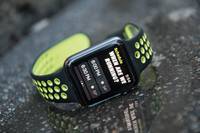 | Apple Watch Series 2 & Nike+ Edition $369 | N/A | |
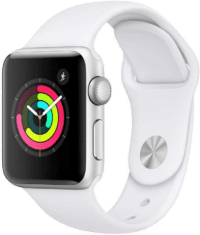 | Apple Watch Series 3 $169-$179 | Amazon | |
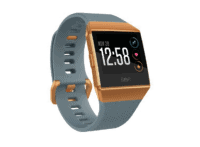 | Fitbit Ionic $229 | Amazon | |
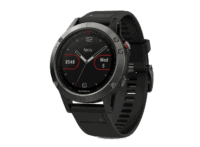 | Garmin Fenix 5 (5/5S/5X) $599 | Amazon | Competitive Cyclist |
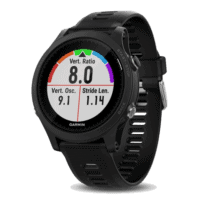 | Garmin Forerunner 935 $499 | Amazon | |
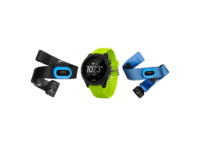 | Garmin Forerunner 935 - Tri Bundle | Amazon | |
 | Garmin Vivoactive 3 $129 | Amazon | |
 | Polar M430 $229 | Amazon | |
 | Polar M600 $329 | Amazon | |
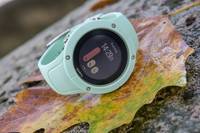 | Suunto Spartan Trainer Wrist HR $279 ($329 for metal bezels) | Amazon | |
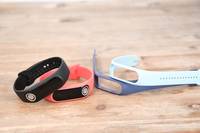 | TomTom Spark 3/Runner 3 $149-$299 (Features Vary) | Amazon |
Triathlon GPS Watches:
This category is for what the industry calls ‘multisport’ watches, but that typically just translates to triathlon watches. They track your time/distance/etc… within the three sports – swim/bike/run. From a non-triathlon multisport aspect, these watches are often used by everyone from wind surfers to skaters, mostly because of their versatility and flexibility in configuration and display customization.
Overall Best in Class: Garmin FR935
There’s a reason that Garmin dominates the category (seriously, look at these stats) – it’s simply got the most features for the price. No other triathlon watch comes close in terms of breadth of features. And unlike competitors, Garmin offers a quick release kit for quickly moving the watch from your wrist to your bike handlebars, and then back to your wrist for running. The FR935 contains all the new training load and recovery metrics and does so across multiple sports.
Like in running, the Fenix 5 also remains a great choice here as long as you don’t care about some 3rd party ANT+ sensors that may have connectivity issues (mainly ones on your feet, though rarely some power meters). And to be fair, most people don’t have issues with other sensors.
Budget Options: Suunto Spartan Trainer Wrist HR
Man, Suunto just nailed it with this $279 watch this season. It’s essentially a small version of the Suunto Spartan Ultra series, just without a barometric altimeter or the ultra-long battery life. It includes all the swim/bike/run goodness you could want, and unlike Garmin, they leave the optical HR sensor enabled during swimming (albeit with varying results). I suspect this will continue to be the best tri-specific budget watch for some time (various sales aside).
Finally – all that said, note that you can find the FR920XT on sale right now for $199, through the holiday periods. I’d personally get the FR920XT over the Suunto Ambit series for purely triathlon purposes. However, if you’re doing more hiking/navigation, then the Ambit series is a better bet.
Note: For triathlon I do NOT recommend the TomTom Cardio/Spark or Vivoactive/Vivoactive HR/Vivoactive 3:
I want to be really clear on this. The reason I don’t recommend these watches is twofold, but mainly centers on the fact that they don’t support a multisport mode. Yes, it supports running, and cycling, and indoor swimming. But you can’t tie all those together in a race or training. Further, they don’t support openwater swimming.
This is pretty similar for some of the other running watches like the Polar M400/M430/M600 or Garmin FR230/235/620/630. Yes, they all support running and cycling, but none support swimming metrics and none support multisport modes. If you cycle sparingly and don’t swim, then they’re all still viable options.
| Product | Amazon | |
|---|---|---|
 | Garmin Forerunner 935 $499 | Amazon |
 | Garmin Forerunner 935 - Tri Bundle | Amazon |
 | Suunto Spartan Trainer Wrist HR $279 ($329 for metal bezels) | Amazon |
Cycling GPS Units:
This is finally the year we saw significant competition from others in the cycling head unit market, a realm that’s long been dominated by Garmin. We saw Wahoo release the ELEMNT BOLT, a very strong competitor to the Edge 520 as well as elements of the Edge 820. Polar refreshed their M460 cycling computer (budget focused) as well as Stages with their data-laden Dash head unit, and even the Xplova series. Then we’ve got still unreleased options that were floated like the Hammerhead Karoo.
Of course, Garmin has also stepped up their game too with firmware updates adding new features as well as their top-end Edge 1030.
Best All Around Cycling GPS: Garmin Edge 520 & Wahoo BOLT
This is the epic battle of the year between these two companies – both offering units at $249USD, an incredible price given the number of features packed into them. I put together a huge head to head post on these units back in August that still stands, so definitely go check that out here.
Both units have minor nuances that may make one better than the other depending on your specific use case. So you kinda want to understand that the devil’s in the details there, but virtually everyone seems happy with whichever one they select.
Note that if you’re looking for mapping, then you’ve gotta decide to what extent you want true turn by turn navigation where you can re-route if you get off-course. Neither the Edge 520 or Wahoo BOLT (or even ELEMNT) can do that. That’s basically the domain today of the Garmin Edge 820 and 1000/1030. Down the road that’ll include others like the Hammerhead Karoo…but not today.
Best Budget GPS Unit: Polar M460 or Lezyne
At about $100 cheaper than the Edge 520/Bolt is the Polar M460. It’s essentially got the core features you want on a GPS bike computer, in a rather nice little size. It can sync your rides afterwards via Bluetooth Smart, and soon also send those completed rides to Strava wirelessly, and even has Strava Live Segments. Plus it even connects to a power meter, unlike its previous generation M450.
Next, we’ve got the Lezyne Super GPS at $149. Lezyne has like 98 different models between $100 and $200, I tried to explain it all here. They’ve all got minor nuances. The strength of this unit over the Polar is the ANT+ sensor support (in addition to Bluetooth sensor support). So if you have ANT+ sensors already, you may want to consider this. Whereas if you have just Bluetooth Smart sensors you’re more of a free agent. Also, this unit features Strava Live Segments while Polar only has Strava integration. On the flipside, they don’t have a lot of the nuanced features you’ll find within the Polar or Garmin lineups. But the budget options are still really solid. Again, check out my detailed post on it to understand those specifics.
| Product | Amazon | Competitive Cyclist | |
|---|---|---|---|
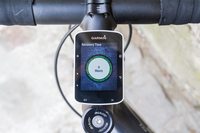 | Garmin Edge 520 $229 | Amazon | |
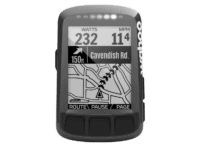 | Wahoo ELEMNT BOLT $229 | Amazon | Competitive Cyclist |
Swimming:
Year after year, swimming gets ignored by companies…and honestly, 2017 is no different than any past year. This is likely since many competitive swimmers don’t like to wear tech (or even a basic watch). So it’s hard to make inroads into the category with such a small market. Still, here’s some thoughts (which are almost identical to last year).
Indoor Pool Watch: “It’s Complicated”…with a side of Vivoactive.
This one is also messy, because I’ve previously recommended (and loved) the Garmin Swim watch. It was roughly sub-$150, but it’s also now like 4-5 years old and basically untouched. From a functionality standpoint it was great having a year-long battery life so it just hung out in your swim bag and sync’d when it was close to your computer. However, it lacked Bluetooth Smart for your phone to download that way, so it’s kinda lost favored nation status.
Instead, your next best bet is the Vivoactive HR, which usually sits around $150-$170 these days. And it’s just as capable in the pool. Plus, it has running and cycling and activity tracking and all sorts of other jazz. Still, I wish there was a Garmin Swim2 with Bluetooth…and done. Until then, my recommendation just stays the same as last year.
Openwater Swim: No good answer
Quite frankly, nobody makes a good dedicated outdoor swim watch. Your best bet here is to either get one of the multisport/triathlon watches for openwater swim mode (on your wrist). If so, check out the budget triathlon section. You’ll find the FR920XT or Suunto Spartan Trainer Wrist HR series is your best bet. I seem to get marginally (barely) better openwater swim accuracy out of the Suunto series. Otherwise just use any GPS you have and plop it in your swimcap using the swimcap method.
MP3 Players: FINIS Neptune
Two years ago FINIS came out with the FINIS Duo in the weeks before my guide. And that’s a good little unit, which built upon the original SwiMP3 and fixed the charging issues found there. However, I personally prefer the slightly older FINIS Neptune
This has been my mainstay recommendation for a swimming MP3 player for about a few years now, mostly because I like the display aspect, since it makes it easy to get things queued up, while the sound quality is also just fine for a pool. And then finally, the buttons also makes it easy. If I look at reader feedback, most are quite happy as well there – with the only complaints coming from folks that require swappage of the device after significant use (which FINIS covers).
| Product | Amazon | Note | |
|---|---|---|---|
| FINIS Neptune Swimming MP3 Player $139 | Amazon | ||
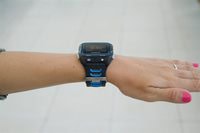 | Garmin Forerunner 920XT $249 | Amazon | |
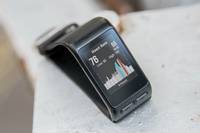 | Garmin Vivoactive HR $249 | Amazon | |
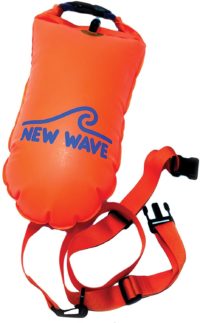 | Openwater Swim Buoy $45 | Amazon | Always openwater swim with a swim buoy. Always. First, it makes it so boats see me. Second, it provides a place to stash my phone/keys/clothes and even sandles. No, you don't feel it behind you. Works great! |
Sensors & Mounts:
If you’re getting any of the units listed above, you may be in the market for accessories. Obviously, some bundles include accessories, while others do not. Here’s what I recommend based on having entire buckets worth of accessories to test with.
In general, almost nothing has changed here in that I strongly favor dual ANT+/Bluetooth Smart sensors over single-channel version (I.e. ANT+ or Bluetooth Smart only). These sensors are available in almost all categories now. The reason for going dual is simple: It allows you the flexibility to choose whichever device you want and know it’ll work with it. Be it using it with apps like Zwift or Strava on Bluetooth Smart, or your Garmin head unit on ANT+. Or both at once!
Heart Rate Sensor (Optical): Scosche Rhythm+
This is my primary and singular running/cycling/hiking/etc heart rate sensor (when not testing something else). I just love it. While I liked the Mio Link wrist straps, I’ve found the signal too weak in some cases and then also not quite as stable as the Scosche from a measurement standpoint. The Scosche is dual ANT+/Bluetooth Smart, so it can transmit to just about anything. I’ve used it now as my primary strap for almost two years. You’ll see it in almost all my tests these days. Note that I do really like the Polar OH-1, and I think the accuracy is just as good there as on the Scosche, however, since it’s not dual ANT+/BLE, it loses the top spot.
Heart Rate Sensor (non-Optical): Wahoo TICKR or 4iiii Viiiiva
Looking for a non-optical HR strap? I mostly use the basic Wahoo TICKR, though occasionally also the 4iiii Viiiiva. The TICKR is nice in that it has small LED’s on it so I can validate the battery hasn’t died. Whereas the Viiiiva has a boatload of extra features around ANT+ to BLE conversion, offline storage, etc…
Note, that I don’t find much value in the Wahoo TICKR X. Lots of cool concepts in theory, none of which I ever use.
Speed/Cadence (Combo): Wahoo BlueSCv2
Wahoo’s BlueSCv2 is what I use when I want a combo speed/cadence sensor, which includes both ANT+ & Bluetooth Smart (dual) Thus, two for the price of one. I love this model though because of the quick release bands making it easy to move between bikes if you need to. You’ll find this on all my bikes where I’m doing power meter testing, as I use the magnets as a ‘known good’ for validating cadence readings.
If however, you’re looking for a cheaper (ANT+ only) combo option, just simply pick up the Garmin GSC-10 – which usually hovers around $30-$35. Bontrager also has a dual option out these days too, but I haven’t tried it yet.
Cadence-Only: Wahoo RPMv2
This one is another unit that you’ll find on many of my test bikes, mostly because of portability. I also take it with me travelling when I’m using a hotel spin bike. It’s a small pod that attaches to the side of your bike crank and it transmits on both ANT+ and Bluetooth Smart, so you can use it with your Garmin device or your smartphone.
Note that technically I find the Garmin cadence-only attachment system slightly better than Wahoo’s, as it doesn’t require zipties. But that’s not enough to sway me from dual ANT+/BLE.
Speed-Only: Wahoo SPEED
This is Wahoo’s dual ANT+/Bluetooth Smart speed-only sensor. I’ve been using it on my bike since (with a review I haven’t quite finished taking photos for…for over a year). It simply attaches to your wheel hub and that’s it. No magnets or anything else to deal with.
Running Footpods (ANT+): The Timex, Suunto, and Garmin mini-footpods (whatever is cheapest that day)
As long as you pick up any of those three above they all work the exact same way and all function with any ANT+ device. In other words, just pick up whatever is cheapest that day. Ensure that you aren’t picking up the giganto footpods of yesteryear. It’s hard finding an ANT+ only footpod these days aside from the Garmin one.
If/when in doubt, check out my post on ‘All you ever wanted to know about the ANT+ footpod’.
Running Footpods (Bluetooth Smart): Milestone Pod
For $29 you won’t find a better deal for a footpod out there. Or heck, any sensor at all. It works great for me, and connects to everything from Strava to a Garmin FR935/Fenix5 (or any 2017 Garmin watch). I’ve been using it for close to a year now.
Note that technically Stryd’s footpod based power meter is also Bluetooth Smart footpod compliant, but that’s a wee bit of overkill in terms of price for just a footpod.
Best ANT+ to BLE Bridging Solution: 4iiii Viiiiva & NPE CABLE
While this may seem an odd category, I keep getting requests for it – so I’m putting it here to assist folks in my recommendation. There is really only one other competitor in this space, which is the Mio Velo. However, I find that 4iiii has done a much better job with the overall ‘package’ on the Viiiiva, which just got a huge pile of cool updates even this week (years after release), including the ability to save data while away from the phone and the ability to work with ANT+ gym equipment (something Garmin watches used to do). Oh, and it’s still a dual ANT+/BLE HR strap.
Meanwhile, NPE CABLE is a tiny little pod that you can stash anywhere. It translates a slew of protocols, including ANT+ FE-C. It’s awesome because it’s not a HR strap, and has a fair bit of geek functionality built-in for those that want it.
I’ve been using it lately though, and showed it off in my recent Zwift Apple TV post as well as my older Zwift Treadmill post.
Bike Computer Mounts (just computer): Barfly Mounts
I love my Barfly, specifically for triathlon, the TT/Aero Barfly. I reviewed it back here, but it just works perfectly. While K-Edge does make some great (and really darn sturdy) mounts for Garmin units, I simply don’t think your Garmin unit needs that much mount durability to justify the price. Note that I easily recommend the Barfly for just the bike computer, but if you plan on attaching an action camera to the same mount, read the next section.
One of the other things I do love about the new Barfly units though is that in the box it has compatibility pieces for every bike computer out there. Garmin, Polar, Wahoo, Mio, etc…. Seriously, all of them. Even has a GoPro mount built in (which is still pretty good). The integration story with BarFly now is awesome and brilliant.
Bike Computer with Action Cam Combo Mount: K-Edge Combo Mounts & BarFly Prime
In the event you’re going to hang an action cam from your bike computer mount, that’s where I typically recommend you transition away from the Barfly mount and more to the K-Edge mount, due to the stability for cameras. Read more on that in my action-cam section though. Seriously, I’ve bought more K-Edge mounts from the store around the corner than I know why I’ve bought them. Actually, I buy so many because sometimes I’ll mount 2-3 mounts on just the front bars alone for action cam comparative testing. These mounts stay-put and make everything awesome.
That said however, I’ve got no issues with the new Barfly rear seat post action cam mount, it’s rock solid too. And their Prime matches what K-Edge has and I’ve been using it lately too in that it’s aluminum based. Plus, it has all the mount adapters for different bike computers in the box.
| Product | Amazon | Competitive Cyclist | |
|---|---|---|---|
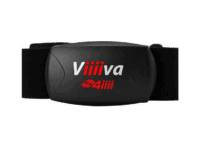 | 4iiii Viiiiva ANT+ to Bluetooth Smart HR Strap & Bridge $79.00 | Amazon | |
| Barfly Prime Out-Front Mount $43 | Amazon | ||
 | Barfly Tate Labs Road Bike Handlebar Mount $25 | Amazon | |
 | Barfly Tate Labs Timetrial/Triathlon Bike Mount $37 | Amazon | |
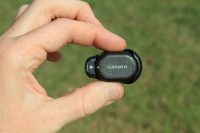 | Garmin ANT+ Running Footpod (Mini) $45 | Amazon | |
 | K-Edge Action Cam Mounts Varies | Amazon | |
| K-Edge Garmin/GoPro Combo Out-Front Mount (Cycling) $53 | Amazon | ||
| K-Edge GoPro Saddle Mount $39 | Amazon | ||
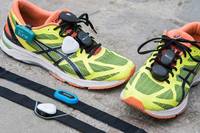 | Milestone Pod $29 | Amazon | |
 | NPE CABLE $59 | Amazon | |
 | Scosche RHYTHM+ $79 | Amazon | |
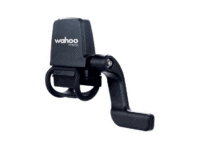 | Wahoo Blue SCv2 - Bluetooth Smart/ANT+ Speed/Cadence Sensor $59 | Amazon | |
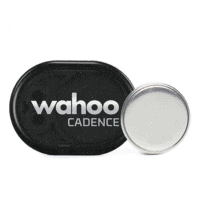 | Wahoo RPM (Bluetooth Smart/ANT+ Cadence Sensor) $34 | Amazon | Competitive Cyclist |
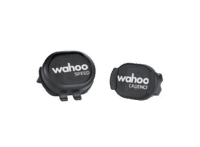 | Wahoo RPM+SPEED Bundle (Dual ANT+/BLE) $69 | Amazon | Competitive Cyclist |
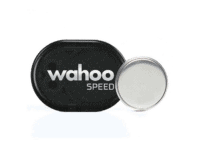 | Wahoo SPEED ANT+/BLE Sensor $39 | Amazon | Competitive Cyclist |
 | Wahoo TICKR X (Original) $79 | Amazon |
Weight Scales (WiFi):
I wrote an entire post about WiFi weight scales two winters ago, and virtually all of it still applies since very little has changed, so it’s probably best to just read that weighty awesomeness. That post also covers how to get the Fitbit/Withings scales to feed data into Garmin Connect and other platforms.
The only things notable since then is that Fitbit released an updated scale this past fall, though the shifts are minor (a unit is on the way to me). Additionally, Withings was bought by Nokia. Nokia has mostly done things to screw up all the good Withings has done, but the scale pieces remain relatively unscathed from a connectivity perspective at this point.
Best Options: Fitbit Aria or Withings Body
I’ve been including little snippets of these scales in my Fitbit Surge and Withings Activité reviews. Overall, either scale is a solid option and really just depends on if you’re aligned to either of those platforms already (Fitbit or Withings). If not, poke at the slight differences with 3rd party partners, and see if either of those partnerships matters. Failing that…flip a coin.
Seriously – they’re near identical scales (exempting the more advanced Withings Body Cardio with advanced metrics like Pulse Wave Velocity). Any other relevant differences are partnerships or platforms. And, again, they’re both great scales. I use them both, frankly just depending on which bathroom I’m in.
*The one exception here is the new Garmin Index scale, if you’re heavily aligned to Garmin and want advanced metrics. But otherwise, I think all of the fancier/higher end scales are overkill compared to these usually $100/sub-$100 options above.
| Product | Amazon | |
|---|---|---|
 | Fitbit Aria WiFi Weight Scale $129 | Amazon |
 | Garmin Index WiFi Scale $149 | Amazon |
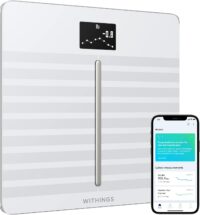 | Withings Body WiFi Scale $59 | Amazon |
Action Cams:
Best All Arounder Action Cam: GoPro Hero6 Black
With GoPro’s Hero6 Black they pull away from the pack this year. It’s just an awesome camera that I use daily in shooting. The inclusion of higher frame rates and resolutions (like 4K60), as well as stabilization, make it easy for me to use the footage across many scenarios. Most notable is the new graphics processor, which while could be mistaken for a marketing spin, the dynamic range performance is awesome (I.e. dark trees to bright field on a mountain bike).
That waterproofing is just key to not having to think or worry about the camera, especially in aquatic situations – especially the beach or with a family. Plus, the size of it is slightly smaller than the VIRB Ultra 30 once you include those cases. The back touchscreen is brilliantly clear, and the video quality is equally as awesome – especially the new linear modes. The new voice control also allows you to not only shout stressfully at your family on that long road trip, but at your camera as well. Plus, the WiFi upload is handy for having all your videos in one spot (even if the quality is degraded). Also, for pros, the ability to record the three internal mic audio tracks to separate .WAV tracks is very helpful. As is the RAW photo mode.
Best Cam for Sports Metrics: Garmin VIRB Ultra 30
If you don’t mind having to take a case along for waterproofing, then go with the Garmin VIRB Ultra 30. I think this may be the best product Garmin has released in years. Most people don’t understand how far Garmin has come in the action cam market in the last few years until you’ve used one. They threw down the gauntlet this year, and from a features standpoint they largely came out on top.
The ability to overlay metrics on it – like power, speed, pace, etc… is so far above and ahead what GoPro has, it’s not even funny. They do a hundred times more stuff than GoPro does in this area, and they do it on desktop and mobile platforms. It’s not even close to a competition, Garmin dominates when it comes to these metrics.
So why not just use the GoPro combined with a Garmin wearable to record the data and mix after the fact? Well, it’s just one more thing to deal with. For me, I find the time savings worth it. So if I’m shooting something that I want to share that type of info (I.e. a ride or something else that would have data overlaid), I’m going to go for the VIRB Ultra 30.
Best 360 Cam: Garmin VIRB 360
I have almost every 360 cam out there in the consumer realm, and the vast majority of them suck. Usually the problem is that they may claim to be 4K, but that’s not the effective resolution that you’ll see on the screen. Instead, that’s closer to 720p at best. With the VIRB 360 they’ve got two 4K lenses, and give you a total of 5.7K of resolution. The clarity is awesome.
But Garmin’s strength is all the data overlay pieces as well as stabilization. The only other cam that has stabilization that approaches this level is Rylo (just announced last week). And while I’m impressed with that camera, I’d call it the ‘best 360 camera that’s not a good 360 camera’. Meaning, it’s great at taking 360° footage and making it flat (1080p), but as a 360° camera? Not as much.
And GoPro Fusion? Also really strong, but the stabilization just isn’t there yet (follow my YouTube channel for some cycling footage in a few hours to demonstrate this). Also, right now GoPro has largely released it targeting a more geek-like crowd and it lacks all the software aspects that Garmin has, which GoPro says are coming next year. They do a lot of good stuff, but right now the win goes to Garmin.
Best Safety Cam: Cycliq Fly6 CE & Fly12 CE
Next we’ve got the Fly6. If you’re not familiar, this isn’t an action cam per se, but it’s the closest category I’ve got. It combines a rear light (which you’d want anyway) with a camera. Basically, this is a safety cam. And not in the sense that it’s going to save your ass, but rather, it’s like an insurance policy for later. I have it on my bikes while riding around the vast majority of the time and it’s just silly easy to use.
Now, this isn’t really a replacement for a GoPro or the like, it doesn’t have that level of quality. Rather – it’s just so in the event something bad happens to you – you can prove it wasn’t your fault, or even better – catch the person if they left you at the scene.
There’s also the Fly12, which is for the front side. I’m not as big of a fan of this since it’s a bit bulky/heavy for my tastes (though, I fully understand why – given longer battery desires). But since there’s nothing else out there…the Fly12 it is.
The new CE version just came out two weeks ago, and starts shipping next week or so. While I haven’t finished my review on it, I think it’d be a mistake to order the older non-CE versions. Here’s my preview post on the new CE ones.
Action Cam Mounts: K-Edge Action Cam Mounts
Now, while I often use the Barfly for my bike computers, I really prefer the K-Edge mounts for my action cams. I’ve come to love the sturdiness of the K-Edge mounts, especially the combo mounts they’ve made (Garmin + GoPro). It’s hard to explain to someone how incredibly rock-solid these mounts are until you attach a camera to them and don’t even get a sliver of a millimeter of sway on them (unlike a stock mount). Incredible. I’ve bought front/back mounts for every bike I have, love them.
| Product | Amazon | |
|---|---|---|
| Garmin VIRB 360 $799 | Amazon | |
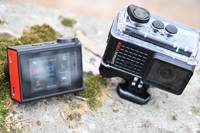 | Garmin VIRB Ultra 30 $399 | Amazon |
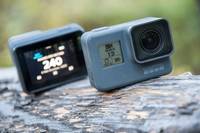 | GoPro Hero6 Black $399 | Amazon |
Drones for Sports:
Drones continue to become more and more popular in sports. And it’s the category I probably have the most fun playing with lately. Likely just because it’s combining a few of my passions: Photography, sports, and aviation.
Drones have advanced so much in the last 1-2 months it’s mind-boggling. Now you’ve got obstacle avoidance, person tracking, 30-minute battery life, 4K stabilized cameras are the norm, and automated cinematic moves are expected.
When it comes to drones you’ve gotta decide what you want the drone for. Is it 100% to capture sports action of yourself, or is it cinematography/photos/etc…with a side of sports action? That will help you decide which drone is best. Personally, I’ve come to prefer an all arounder, since I think it’s more useful on vacations/etc.
Best All Around Drone: DJI Spark
Wait…what? Not the DJI Mavic? Look, I love my Mavic – I really do. And yes, it obviously has better resolution (4K) than the DJI Spark, and longer flight time. But for portability the Spark can’t be beat. I can stash it in my jersey pocket and get shots like this while cycling in the alps.
Plus, for Black Friday it’s down to $399, which is nuts (the shot I got above was taken without a remote controller, just my phone). Meanwhile, my full in-depth review shows other sports usage aspects. Note that as good as the Spark (and Mavic) are, they don’t have a very good follow-me type mode for sports. In DJI parlance, it’s called ‘Active Track’, and it works fine in an empty field, but throw a few trees in the way and it quickly gets lost.
As for why not the GoPro Karma? C’mon now, nobody can seriously recommend that in comparison to anything else out there.
Best Solo Shooting Sports Action Drone: Airdog ADII
If you’re shooting yourself, then the Airdog is the clear winner here still. The Airdog is really focused on shooting sports action, and it’s really not all that great at general cinematography – though the new ADII does improve that a bit, but it’s still not my first choice for general drone footage. But the unit differs from every other drone on the market in that it has a small waterproof transmitter that you wear on your arm. That transmitter includes controls, but also GPS tracking so that the drone can follow not just your position but also your altitude.
That ensures the drone can follow you – even through the trees, which is something that causes the DJI drones challenges with their ‘Active Track’, which follows you with its camera. Yes, you can use the follow-me mode for controller following, but that’s also limited in terms of altitude changes and camera moves. With the Airdog you have numerous ways you can position the camera, both preset and on the fly.
Again, if you plan to film yourself, the Airdog is your better bet. Whereas if you have a buddy to film all your exploits, the Mavic or Spark is the better bet.
| Product | Amazon | B&H Photo | |
|---|---|---|---|
 | Airdog ADII (2nd Gen) $1,199 | N/A | N/A |
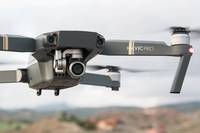 | DJI Mavic Pro $999 | Amazon | B&H |
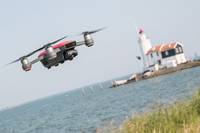 | DJI Spark $499 ($549 combo) | Amazon | B&H |
Activity Trackers:
So…here’s the thing, in the past, I used to have a section here on activity trackers. But the market has simply gotten so big, and the features in general overlap each other on so many units. It’s nearly impossible to simply say “Go get a Fitbit” or “Go get a Polar Loop” or “Go Get a Jawbone” (actually, no, don’t get a Jawbone).
Instead, it’s really best to look at whatever activity trackers either:
A) Your friends are using
B) Your existing device is on
Seriously. If you’re motivated by competing with friends, then you want to be on the same platform as them. So if they’re all on Fitbit – go get a Fitbit. And same goes for Garmin or Withings, or anyone else.
Secondly, if you already have (for example) a Garmin device, heck, it’s likely it has an activity tracker in it. But say you want something else – in that case, get something on the same platform as that – so you can track everything in one place. It’d make no sense to have a Fitbit activity tracker and a Garmin GPS watch.
There are of course nuances to each unit out there. Some do optical HR slightly better than others. While some have more sports modes than others. And some have coaching, while others have better smartphone integration. And of course, now some even have GPS (like the Vivosmart HR+ and Vivosport). Most of them are within a pretty small price window, so it’s really best to figure out what suits you.
Next to last – the vast majority of activity trackers are roughly accurate. To that I meant that no activity tracker on the market is perfect. None. Instead, they are estimations – treat them as such. Each company tries to fine tune their algorithms for various use cases. Some might be better at guarding against false positives in the shower, but less so doing dishes. Others the inverse. What matters is that at the end of the day if your activity tracker said you only did 2,000 steps, and your goal was 10,000 steps – then you were…lazy. Meanwhile, if it says you did 9,782 steps and you think you really did 9,923 or 9,458 – just go walk around the block an extra time. It’s about tracking trends – not exacts.
Lastly, in general I prefer activity trackers that have a display on them. If I didn’t need a display, then most phones these days can track 99% of your awake time anyway. So for me, I want to be able to glance at my wrist and see how many steps I have and how far from a goal I am.
Cycling Power Meters:
Choosing a power meter is a tough decision matrix. Anyone who answers the question “Which power meter should I choose?” and instantly names a specific brand name/model upfront, is full of crap. The correct answer is “Tell me more about your usage plans?”
There are so many variables that go into that decision beyond just price. For example: How many bikes? What type of bike? What type of pedals? Do you want to move it around a lot? Race wheels or not? What do you want to measure? And on and on.
The good news is that I cover these in-depth in my Power Meter Buyer’s Guide from just a week or so ago. Nothing has changed there since then (neither in products nor in my opinions), and I don’t expect any shifts till at least next spring.
Cycling Trainers:
The best way to cover this section is to go read my complete winter 2017-2018 cycling trainers guide, so again like power meters, I’d go over and check out that post for all my recommendations (a massive list on a slew of categories).
Obviously, given it’s now basically the trainer season, there’s no more trainers coming out till at the earliest mid-next year, with most announcements typically happening at Eurobike in July next year (a shift from August).
Don’t Forget the Product Comparison Tool:
Ok, lots of recommendations. If there’s a category I’ve missed (entirely plausible) – just drop a note in the comments and I’ll try and come up with a recommendation and add it above.
More importantly though, you can mix and match just about everything I’ve talked about above, with in-depth comparison tables over at the product comparison calculator, which today supports: Action Cameras, Drones, Heart Rate Straps, Watches/Bike Computers, Power Meters, Activity Monitors, and Trainers.
Select product use/budget for a comparison from the drop down menus:
Note: While many running watches have a basic bike mode, only running units that are multi-sport focused are also included in the bike-only results (in addition to bike-specific units). Hiking units are those that include a Barometric Altimeter, Magnetic Compass and navigational functions.
Or select products for comparison by clicking the product boxes below:
—
As always, thanks for reading – and supporting the site!





























Hi Ray,
So close to buying the FR935, but does it have too much stuff that a runner doesn’t need? Also afraid that the 645 or 245 could come in Jan. If we could only see the future:(
Thanks for the info
Sainttoff
I think you’ll continue to see the top-end Forerunner lines get closer in closer in functionality to the point there won’t be much of a difference.
Certainly both the FR235/FR630 are slightly over-due for replacement, but even if we do see new watch announcements at CES, it’s historically often months till stock is available.
Similar, I’m a runner/hiker. The Garmin 235 does all I need from a running perspective, but I’d like a barometric altimeter for hill runs/walks. The 935 has so much bike/swim stuff I’d never use, now if only they’d release the 245, ie a 235 with a barometric altimeter………….
Look at the Vivoactive 3, in a lot of ways it is a 235 with baro. Just a matter of what you think about touchscreen interfaces on a watch.
But Vivoactive lacks alot of the running features a runner would need :(
The Vivoactive 3 lacks them? Which features?
I think you might be surprised at how many features are on it now.
It lacks manual lap feature which is a great feature for interval training. Lacks virtual training partner, lacks training load, training effect if anaerobic or aerobic and also finishing time just to list a few.
It has manual lap these days, got it a month ago.
While it doesn’t have virtual training, you can do virtual pacing. No doubt it doesn’t have the higher end training load/training firstbeat features, but those are all new 2017 features only on the Fenix5/FR935.
Ah cool, thanks for that. The manual lap thing was one of the features that I would need. Garmin website needs to be updated when comparing the watches!
Now I have to think again!!!
I returned my VivoActive 3 today because of the manual lap issue. I think this is crucial for people to understand if they are considering the VA3 as a running watch. Manual lap is done by double tapping the screen, which works about 75% of the time when you’re sitting in a chair but is much more error-prone when you’re actually running. If you plan to use this watch for interval workouts on a track, ask yourself whether you really want to rely on double tapping the screen at the start and end of each interval. I liked the watch for regular road running, but couldn’t justify spending $300 on a watch that I end up leaving at home every time I do a track workout.
And by the way, Garmin doesn’t sound like they are planning on addressing this issue in the future. Here is the response I got from garmin when I asked them about it: “I apologize for the inconvenience, I understand this is frustrating, the Vivoactive 3 is a Vivo device with less training features that you were used to on the Forerunner 230. The Vivoactive 3 does still have auto lap just no way to manual lap.”
Too bad. Nice watch, but it’s missing a feature that every $20 timex supports.
Glad to see the MilestonePod get some love. But you didn’t mention that it also works independently of any device to track your workout. And the app is easy to use.
I use mine as a backup device in case my gps gets wonky
Ray, great information as always. Thank you.
I think you have a typo in the first paragraph of the DJI Spark portion of your article. .
…But for portability the Spark can’t be best…
Eric
Would CABLE allow a Bluetooth device (Polar OH1) to communicate with a Garmin 510?
Great work Ray,
New baby and churning out the content!
Andrew
Thanks!
No category of bike computers for “best to follow a RWGPS or other downloaded route” for those who care more about navigation? (Major advantage of the Lyzene over the Polar for a cheap device as even their $100 version has it)
Yeah, I kinda tried to reel in some of the categories this year a bit. I feel like it just spirals out of control somewhat.
But aren’t most people looking for:
– cheap
– racer focused – just the data and what can help them with training
– group ride – distance and directions and basically being able to replace the cue sheet with a gps
At least thats how it falls around here. I think you downplay the importance of getting one for following a route, they aren’t all caring about power data
Hi DC,
Finis Neptune: Agree, they are nice BUT just fyi … I actually just called Finis b/c one of the plastic clips broke (where goggle straps go through). I just need one to clip back, can’t be more than $ 5 part, but they no longer stock this part. I have to McGyver it now!
For best all rounder, why isn’t the 735xt being considered? It’s now in price range of Vivoactive 3, Suunto’s Spartan Trainer AND is a full blown Tri watch. 735xt does not seem to be outdated at all.
The FR735XT is definitely a solid option at the sale price (I think I mentioned it above – $299). Whereas at $349 that’s $75 more.
Thanks for the great list Ray! I’ve been on the hunt for an action camera to use for cycling, and I have a follow-up question for you:
I like the Garmin Virb Ultra 30, so it’s good to see it on your list here! BUT, I have read that the battery life is horrible—folks are saying they barely get 60 minutes even after turning off wifi, etc. My goal is to take it on long rides, so this concerns me. Also, it still seems pricey at $400 when there are others like the Yi 4K+ which seem to have better performance and longer battery life at a lower price point (according to the reviews at least).
I’m not a pro and don’t plan to spend a lot of time editing for perfection. Just want to capture some memories. I love the idea of overlaying my metrics (I have a VAHR & Garmin speed/cadence sensors), but this isn’t mandatory. I basically just want a decent quality camera with good stabilization and the longest possible battery life.
Considering this, what do you think? Stick with the Virb? Or do you recommend something else that would suit my needs?
The 60 minute time is for 4K footage though, and honestly the GoPro is in basically the same ballpark. If you’re not super big into editing and such, then you can shoot at 1080p and save a boatload on battery burn.
I think if you don’t plan to overlay metrics, then going with GoPro makes sense. Though, even if you have a GoPro and have other Garmin VAHR files (as you do), then you can still use Garmin’s VIRB Edit suite with it to achieve the same thing. Not instant quick, but still really simple.
This is helpful, thanks. So, if $500 just isn’t happening, would you go with an older model GoPro over the Virb Ultra 30? Or is it a “you really can’t go wrong with either” scenario?
If comparing an older GoPro (i.e. Hero5 Black), then you can’t really go wrong either way. If comparing anything else, then go VIRB.
Good stuff, thanks, Ray. Are you going to update the list of things you/your wife use? I almost find that more interesting than reviews/round-ups to see what you chose to use when you’re not “forced” to use something for a review
Yeah, I’m hoping to in the coming weeks. I know it’s horribly outdated.
Short version:
Running/Swimming/Tri: FR935
Cycling: Edge 520 with a side of Edge 1030
HR: Blend of Scosche and TICKR
Trainer: Tacx Neo
Power Meter: PowerTap P1/Vector 3
The Girl: Fenix 5S (she hasn’t done as much cycling lately)
Just purchased Scosche RHYTHM+ for $59.95 at CleverTraining w/ VIP. That is $20 off. Thanks Ray!
Hi Ray- What about a “home base” software for analysis/ progress/ training planning? I’m looking to raise my game from recreational to competition, with some more analysis and structure but not with a coach yet- maybe in future years. Thinking about software I’d want to use for years to come for the body of knowledge it creates. I’ve been spread of Timex, Polar, Apple, Strava, etc. over the years.
Now I use Garmin 935/ Edge 1030, some Apple Watch 2. Tacx Neo w. Zwift. Strava for sharing and some analysis & Garmin Connect for logging/ analysis. I’m newer to the Garmin world this year. Can I do it all (well enough) in Connect? or Strava- or is Training Peaks or another worth a subscription and long term commitment?
So, would your best “cycling watches” fall under those in the Triatholon category? I like wearing a watch with an optical HR over a chest strap and gps head unit. Do any of those pair with power meters?
Yeah, I’d go with the triathlon category/realm watches. All of them pair with power meters.
I realize you mention the Vivoactive HR as a swim watch, but I would think it is also the best sub $200 running (or cycling, or …) watch as well, it may even challenge for best all-arounder. It is currently priced on Amazon at $142.95. I’m not sure if that is just a current sale or not, but since the Vivoactive 3 came out, you can usually get it for less than $200. It includes all the latest ConnectIQ goodness (even running power from Garmin) as well as tons of sports including Ski sports with run tracking, and Golf with downloadable courses (although NOT open water swim). The GPS and HR are very accurate (better than my new fancy Apple Watch). I don’t think I will be upgrading to the Vivoactive 3 (at least at this point), due to the wonkiness of the data fields. I currently use a single data field for my first data field with a ConnectIQ multi field that gives me most of the data I want, but then use the other pages for lap fields or other stuff depending on what I am doing, You can’t do that on the VA 3 since once you’ve set the first field to just 1 data field all the rest of the pages are only 1 as well and you can only use 2 CIQ data fields altogether, so it is kind of a downgrade from the VA HR (as well as the limits on some of the other data fields). I like the form factor of VA 3 and the inclusion of workouts (and maybe if they included open water swim I might think differently) but the VA HR is really just a great all around fitness watch, more useful than my new Apple Watch 3 (although streaming music without the phone is cool and it sure is pretty).
It’s actually even now (as of this minute) down to $119, which is nuts: link to amzn.to
I do agree, it’s definitely a budget contender. One of the things I try and avoid is having temporary sales drive the product recommendations – instead, I usually acknowledge that it would move it into a given category recommendation at a given price.
You are right, since you don’t want your advice to only last for the length of a sale, but since the VA 3 came out the VA HR has been at $200 or less pretty consistently. That being said I just want to thank you for your reviews and recommendations. Now if I can find someone to be as thorough in other areas of my life, things would be much easier. And doing all this with a new baby, kind of amazing, Thanks.
Hi Ray,
I’ve been looking for a GPS watch for a while now and seeing as the Black Friday sales are coming up, I thought I might snag one. The problem is, I’m not sure which would best fit me. I’m on a college student budget (aka less $ the better) and currently have a Garmin HR Strap (I think ANT only). I’m mainly training for an Ironman but don’t think I have the $$ for a full-blown tri watch. Have a Garmin Edge 500 for cycling but would like a watch to at least track my running and some swimming as well as have a HR monitor for daily life. Any suggestions? Also, the 920xt looks like a great deal now but hoping for a less bulky watch.
Thank you Ray for all this work, especially after the recent P2 unboxing.
Happy Thanksgiving !
If only NPE had a Black Friday deal for Wasp / CABLE.
There was a Black Friday deal. Follow on social media (FB, Insta, LinkdIn) for latest deals and updates. There is a winter sale right now for Europe, Australia, and New Zealand.
Pure Awesomeness!! Thanks Ray! Happy Thanksgiving to you and your growing family.
Great work as per usual Ray.
Quick one, have you heard any rumblings of an update/replacement to the FR735XT?
I currently have it and love it (bar the inaccuracy capturing indoor swim distance)
Thanks,
Ruairí
The Cycliq Duo mount is also worthy of a mention for mounting both computers and action cameras. It’s designed to support the Fly12 as well as a computer, so is well up to supporting an action camera.
Thanks for putting this together!
One quick thing to point out and probably worth a mention. Withings was bought out by Nokia and all their products are rebranded Nokia Health now.
Hi Ray,
Suunto has the Spartan Sport Wrist HR on sale for $349 which is only $20 more than the Spart Trainer HR with metal bezel ($50 with Clever Training discount). What are the primary trade-offs between these two watches other than the $50?
The Sport Wrist HR is a bigger/bulkier unit. It’s also got a prettier display.
I actually prefer the smaller units personally, and I do think that the Trainer actually has better GPS accuracy (a lot better).
Ray,
Curious/question on the drone front. Have a phantom 3 standard that gets limited use because: not very portable, and poor range in CE/european mode.
Understand the spark to have the same limitations / range in CE mode (whereas quite decent in US mode), but alluring for portability. Mavic should do much better range thanks to different transmission, and looks reasonably portable, yet you favour the spark…
Do you not find range a problem (spark)?
Is the mavic less portable than it looks: I often can’t fit a p3 in carry on, thought mavic no problem and might go in a jersey pocket at a pinch?
I think I favor the Spark for sport type usage because of portability, and more than that, I’ve found that as much as I thought I’d hate phone control for the Spark – it actually works reasonably well for the shots I want, which means range isn’t too much an issue (I also have the remote too of course).
Meaning that most shots I take are of myself or family, and usually destined for Instagram/Facebook or here. With that, there’s a subject involved – often on a bike or doing something sporty. So if I get too far away from the subject, it’s no longer interesting/visible. So if I’m the distance beyond range of the Spark to phone, then the subject isn’t of much interest to me. Just my two cents.
Obviously, there are many other uses for Drones than just myself. So if you’re more into far reaching landscape stuff where distance is important – then you might want to go Mavic.
I can confirm Mavic will fit in your jersey pocket (even with the remote). I think I have some shots of that in my DJI Mavic Review. Certainly done a few rides with it that way. Not much different than sticking a small water bottle back there: link to dcrainmaker.com
Thanks Ray. Tricky decision, esp when the spark price is so attractive, but the P3 has to go, and now is probably a good time to buy :)
I cannot recommend the Garmin quick release kit. I lost one watch to the depths during an open-water race while rounding a buoy in the midst of a crowd. I nearly lost it’s replacement as I had carried it in my hand out of T2, then fumbled it while trying to mount it back to the wrist band. As the watch to the fell to the ground I inadvertently kicked it forward and it stopped, teetering on the edge of a storm drain!
Which watch though?
The earlier quick release kits (310XT/910XT) were less secure. Whereas the quick release kits these days are virtually impossible to pop-off.
910xt. Thanks for pointing out my error. I am appreciative of all you do Ray. Thank you.
Hey Ray, et al
Just got Easton EC90 aero bars and looking for a combo mount, it’s a tough/tight fit and haven’t found a combo solution as yet. Any thoughts (besides different bars)?
Oh should also say computer is garmin edge 1030
Yeah, it’s really tough. I think Barfly has a mount that goes into the front of the stem bolt area, so may be worth checking there.
Nice job Ray.
Are you aware of any companies that’ll be coming out with a dual-side powermeter for MTB anytime soon? Currently, Power2Max is the only player in that niche.
Hi Ray. Suppose money no object and looking for action cam. By which I mean not looking to replace SLR but portable enough to always have and robust (waterproof enough) to not worry about. Would Virb 360 for that be just overkill expense compared to Hero6 or would you expect better quality from the Gopro on normal pictures. So long as I know that they’re in there somewhere then (some) faff on the laptop later to crop the shot back from 360 is fine and in some ways seems preferable to having to consider framing/composition etc at the time. May be that the cost difference will drive the decision but unsure from what you’ve said whether other factors come into play.
I’d say the VIRB 360 would not only be a bit overkill, but probably a bit more frustrating than just a traditional action cam. Just my two cents.
I love the VIRB 360, but I think unless you really want to shoot 360 content, I’d go with the Ultra 30 or the GoPro Hero 6.
……. though as of this morning approx same price on Amazon UK £499. Unclear if that’s black Friday one-off or not.
I hear you though about the awkwardness. Suspect you prefer image quality of hero6 also?
I do.
I use both the Wahoo BlueSC and the RPM and Speed sensors on various road bikes. Extremely reliable and the battery life is awesome. When you mentioned the RPM sensor you neglected it’s most usable feature. It will attach to the shoe directly. Take the speed sensor from one wheel to another wheel in 30 seconds and with the cadence attached to the shoe you can swap bikes in a minute. The sensor can be swapped between shoes just as quickly.
thanks for your hard work
Hey Ray, having just ordered some rebranded withings/Nokia products, what exactly has Nokia done to screw up the former Withings? Thanks as always.
Will the Garmin Virb attach to the bottom of the mount that comes with the Garmin headlight? Thanks.
Not the older lights, but it is compatible with the UT-800 light mount.h
I know you mentioned to not buy the non-CE Fly12, however today (Cyber Monday) Amazon and Cycliq has the old model Fly12 for $169. That price point changes things, at least for me,
Thanks Ray for this post – especially as you deal with P2! When we had our second, I found that while we knew how to handle one, any confidence was somewhat misplaced because handling two is quite a bit different (duh!), so we found ourselves in learning mode all over again. I hope it’s going better for y’all than it did for us :-)
I love the Scosche and have used it since you first reviewed it a couple years ago. Just curious if any updates on HRV? I know that technically it might be extremely difficult, but it would be nice to have something useful there. Also, I still have very low cal counts (Fenix 3 user). I read that this was supposed to be addressed through a firmware update, but I’ve not seen it even with units bought in the last 6 months. Something I missed?
Thanks again Ray.
Hi David!
Nothing new on HRV, and I don’t expect any advanced there soon.
For HRV at rest, that’s pretty commonplace now for optical. But in a workout, it’s harder than people initially thought. :(
Thanks Ray – great timing. Can send to the wife with highlights.
One question – the VIRB Ultra 30 has been out since August 2016. Shouldnt we be expecting an update during 2018 on this? Feel nervous buying now if they fix some of the bugs you raised eg case.
Toby
I’d be surprised if they don’t release a new version in 2018, but I also don’t suspect we’ll see that be soon either. My guess would either be something like late spring (to one-up GoPro ahead of the busy summer season, who follows a September timeframe). Or in Septemberish like previous.
Personally, if I was running the business I would do it in late spring, since GoPro is very conservative on resolution/etc advanced, so you could easily one-up them and know with reasonable certainty that your unit would have a spec advantage depending on how you outfitted it.
Hi Ray,
I was trying to get a discount thru your code DCR10BTF at clevertraining but for some reason the code doesn’t work for Garmin Index Smart Scale. Site says: Oops! Terms of coupon are not met.
Can you please advise is the product is eligible for the discount and is there a way to get some bucks off? :)
Thanks,
Anton
Hi Anton-
Indeed, for Garmin products the straight coupon code won’t work (due to Garmin restriction). Instead though, you can use the DCR/CT VIP program to get 10% back in points: link to dcrainmaker.com
Thanks for the support!
Go to order the Milestone Pod at Clever Training and says discontinued by manufacturer. What’s up? Milestone Pod website still selling and Amazon too.
Milestone pod is still in business and all that. CT just stopped carrying it. I don’t think CT’s sales system has an entry for ‘We’ve stopped carrying it but the company is still alive’. I think they can discontinue the listing altogether. But, it’s a good reminder for me to pull the link from my post to CT for that item…
Thanks, Ray. I’m bummed about TomTom and would like to swap out sooner, rather than later. Are there other companies that you think have shaky prospects, or, conversely, seem to be pretty stable?
All the other majors are pretty stable at this point. I can’t think of any specific examples of ones I’d be concerned about beyond TomTom. Smaller or less well structured entities like Withings perhaps (I know, owned by Nokia, but CES will be telling on whether Nokia really cares or not).
Thanks, Ray!
The Polar M600 does have swimming metrics since it was updated to Android Wear 2.0. Also, its metrics have been pretty spot on for me.
Now that the Fenix 5 (not Sapphire) can be found for about the same price as the FR 935 on some sites, do you still prefer the 935?
For me, the preference for the FR935 versus the Fenix 5 isn’t so much about price, rather, two distinct items:
A) Size/weight: I just prefer smaller/lighter watches
B) ANT+/BLE Connectivity: The FR935 doesn’t have the same droppage issues the Fenix 5/5S does (the 5X doesn’t have said issues).
Cheers!
You mentioned the Garmin GSC-10 Cad/speed sensor. This sensor has been out of production for years and I doubt anyone can find one for sale. I tried about six months ago and only used ones were available on Ebay.
Interesting in this article you totally didn’t mention the v800, yes it’s old but you mention the Garmin swim watch. Open water swim in particular is one category it would Trump all competition with active hr and gps tracking as well as ows swim metrics. It is also still competitive in other categories although certainly not latest and greatest, and has its faults, it’s still an active product. I hope maybe the omission from current comparisons will encourage polar for something new and updated, but in the meantime it is still a competitor with still the most accurate gps and he tracking on the market with a polar strap. And a very long feature list now that it didn’t have years ago, including go pro controls, video overlays, Strava segments just added, just surprising it didn’t merit at least a mention.
Hi. I am really glad that I found your website. I have been looking for a site like this quite some time and don’t know how I missed it. In depth and great information!
I am looking to get my first fitness watch and would like a little guidance. I have read a few of your reviews already but the amount of information present can be a bit overwhelming especially since I am new to the game. As a college student I cannot afford a top of the line product but if someone recommends something that checks all the boxes I would be willing to put off a purchase to save up.
I am looking for something that is good for running, swimming, gym strength/hiit workouts with the ability to sync some accessories that could further enhance HR and other metrics. Other nice features would be something that could tell me recovery, 24/7 HR, under/over training, stress and fitness tests. I have looked at Vivoactive HR, Spartan Trainer and Forerunner 920 reviews here but cannot really tell which one would be best or if there is another option that might be better suited for me.
Thanks in advance from anyone that can help and sorry for the long ramble.
Andrew
Another reason for not getting to gopro drone:
link to engadget.com
Ray, I notice that the GoPro Hero cameras are consistently at the top of your list. Now that the Hero5 Black price has dropped, I considered getting one. BUT here’s my concern…
No matter where I go online, I find mostly terrible reviews of not only the cameras, but the customer service. So many people complain of receiving defective units—cameras that won’t charge or power on, defective batteries, constant freezes, this list goes on. This makes me reeeeeeallly nervous about spending so much money on their product.
What gives? Any GoPro owners out there who can chime in? Do you love your camera, or have you had the same issues? What’s my best option at $300 or less?
I wrote up a similar answer last week, but I can’t quite find it at the moment. In any case.
I think most bad GoPro reviews fall into two and a half buckets:
A) People who have faulty/fake SD cards. This is true of most issues I see on action cameras. Amazon is flooded with fake SD cards that crap out. And this can legit cause a lot of issues.
B) Fake reviews. The strength of the non-GoPro camera companies is surprisingly strong. I see it across all my various platforms, with fake reviews coming in from 3rd party companies. Sometimes it’s easy to spot, sometimes not. But it’s overwhelming. These are designed to hurt GoPro. Note, GoPro used to participate in similar efforts in the other direction, but I haven’t seen much evidence of that in the last 2 years or so.
Barely C) People who have legit problems.
When I see comments about customer service, that’s an easy fake one (imho). In large part because anyone who’s ever contact GoPro knows how silly easy their customer service is. Straight up real people answer the phone from your region, and in my experiance as a normal consumer calling support – I’ve had really good luck there. I’ve also done some limited e-mail support. I haven’t tried any other venues.
As far as issues, I’ve only had one near-term one, which was on one of my Hero5 Black cameras a year ago that I think developed a hairline crack in the display, and in turn some water got in the unit and caused some bad display things. Could have been my fault, maybe not, not sure.
Hey DC Rain! So I had been using my Garmin 310 xt with polar chest strap for heart rate for 4 years. Well now it does not even recognize the strap etc. So I am on the hunt for a good running watch that is pretty basic but reliable. I train by heart rate too so need something that is pretty reliable in that way. Do you use a chest strap with your 935 xt? how do you measure your heart rate while running? I am looking at the FR 230 and using my garmin chest strap or polar strap with garmin transmitter, what do you think? or since those are now in the past are there any good recent running watches that are similar and reliable? What are your thoughts? can you please recommend a few running watches under 300$ and heart rate transmitters? Thanks very much! Love your site…so helpful but there are so many options out there! argh! Help help!! Going to buy in a few days so hope to hear back from you. I am not against the optical hr monitor but heard those are unreliable and I frequently run intervals…
My beloved Garmin 620 is dying piece by piece – the small pins in the charger cradle get stuck so occasionally it won’t charge and now the battery in the heart rate monitor has died and one of the tiny screws got stripped so I am unable to replace the battery as the back of the heart rate unit won’t come off. I am in the market for a new watch – mostly for running – and am torn between the 735 or going all out for the 935 (just because of all the techy bits not cause I need the functionality).
I noticed that you were a fan of the 620 also – any reccomendations for a replacement
Hi Ray:
10 year ago, I had a health problem and now, I have a pacemaker, but I keep doing daily exercise: swimming (2km), running (max 10km), gim also windsurf and trekking. For that I need the best heart rate sensor (direct measuring) for my training session. I use the M200 and M400 for trekking, run, gim but for swin and windsurf I only use the old RS300 by polar with strap (nowadys the best for swin). I would like to have a good wirst heart rate sensor for water, the M200 dont runs very good.
Do you have any solutions, I know my special situation.
Best
Mario Iglesias
Mario, the scosche ant+ rhythm is pretty accurate. You can wear on forearm or bicep. Ray did a great review on it and I believe tgat is his go to hrm. It does not display hr abd you need to pair it with an ant+ watch. Check his review out. I just got mine and it works pretty well on my forearm.
Ray,
Your site is great and has helped me several times, however I can’t quite figure our next purchase. We’re both wildland fire fighters so running, hiking (ABC fucntions) and doing regular style workouts are the norm. We also do a little biking and swimming, but nothing worth really tracking metrics for. I love my Fenix 5X, however she doesn’t want to spend the money on one. So she’s looking for a watch with Optical HR, barometer based altitude, can track regular workouts HR/intensity, along with Steps and sleep. I’m not sure if any of the chest strap HRM besides the swim record data and then transmit it when they reconnect, but that would be awesome as she can’t wear a watch while doing BJJ. If it can give/track GPS points that’s nice too, but no need for maps on the watch. Battery life is very important as we typically go 1-2 weeks without being near charging ports, however she does have a battery pack so she can charge it while out on assignment. Budget is in the $250-400 range.
Hi. I appreciate verry much your reviews, and i think u could give me an advice even you are usualy doing much complicated things.
I want to buy an ~300 – 350 $ watch, and i want it to do “everything”. Uses: hiking, running, cicling, swimming and fitness. I will not go for any competitions. At list, not now.
And i want it to be suitable for everyday use, This mean to be “goodlooking”. Which one do u recommend?
I like how Garmin Fenix 3 (and GF 5, of course, but is pricey) looks, but i think is outdated, or soon it will be. On the other side, Vivoactive 3 looks too “les complicated”, but, can be a choice finally. Do i have other choices? Enlighten me, please!
Regars, Andrei.
Andrei, if you’re going to be doing a lot of outdoors exercising, that means sweating. And if you’ve ever tried to use a cell phone while your hands are sweaty, you know that a capacitive touch screen while exercising can be a bit of a pain. For me, that’s one of the understated features of the Fenix 5 – no touchscreen. Nothing to accidentally let a drop of sweat change my display while running, or have to poke at a dozen times to stop my time at the end because it’s not properly registering my touches because my fingers are sweaty. Buttons work, always. And they’re precise. Push the button, get only the result that’s expected. Something to consider in your purchase.
Hi Ray, I’ve been eyeing smart-scales (hoping for at least %body fat and %water). I’m a garmin devotee for the most part, but was also imagining paying less than the garmin Index currently costs. I had been looking at the Withings (now Nokia) Body+ Wi-Fi Smart Scale but have heard that the app/web platforms are now total garbage post-Nokia takeover. Any thoughts/Advice suggestions on this topic? I use TP as my overall training platform, so was thinking I wasn’t too fussed if my metrics don’t go through Garmin so long as they eventually end up in TPs. Thanks in advance. ~A
FWIW, my withings/Nokia scales work flawlessly with TP, Zwift, MFP, Garmin (via MFP) etc…. It seems everything talk to Withings.
I rarely, if ever, use the Nokia app itself.
Amy I have a Nokia Body + scale and am also pretty much exclusively a Gamin Connect User. All I had to do was install the Nokia App, MFP, and then Garmin Connect happily pulled SOME of the data from the scale. I say some because body fat, BMI, bone density, and muscle mass are not tracked in Garmin Connect, so they don’t get pulled. I picked mine up for $75 on an Amazon sale, and it’s worked great since.
I just got the Garmin FR 935. Came from the 735XT, which was stolen from me. First impression on the 935 is; bad fit on my small/medium wrist. The 935 is bigger than the 735XT and is not nearly as comfortable. Ironically the actual size of the screen (with a big bezel around it) is a tiny bit smaller than the 735XT, but the watch is still much wider. The 935 just doesnt feel designed to be slim and fast as it wobbles on my wrist Not in the pool, or even on the wrist in the aeroposition. The way it sits on my wrist makes bit of a contrast to the way the skinsuit hugs my body. I know these are totally insignificant margins, but still, the watch is expensive and should fit better.
I am driven by performance, rather than looks btw. I appreciate good looking equipment, but not at the cost of comfort (and God forbid speed :) ).
So, my reccomendation would maybe be the 735XT over the 935, (if you are the hardcore triathlete who appreciates slim physical design over features such as wi-fi, barometric pressure, and looks in the office). Battery life is not that good on 735XT, but if you can finish the Ironman in less than 11 hours you should be good.
The 935 is still an extremely competent watch, it is just not perfect fit (on my wrist.
Anyone have a good HRM for swimming in a pool? I don’t think a fitbit does this, or does it well?
I still use a Polar H10, and for those of us non garmin folks this is a great heart rate sensor. It should satisfy runners, bikers, swimmers, and other fitness enthusiasts.
Hi
Love your reviews but do have anything about quality over time? I’ve been a long time user of Garmin Forerunner products, Garmin Forerunner 605, 610, and 35. I settled for the 35 after realizing that the 6XX series had a lot of features that I never used.
My single biggest complaint is that they don’t last over time. They work great for a year or so, but then have issues, so you have to replace them. I’m on my second Forerunner 35 as Garmin Replaced the first one for free.
These aren’t exactly cheap devices, so replacing them because they stop correctly is frustrating.
It’s always hard to know for certain, as what I find is that for most sports tech products it tends to be very individual.
Which isn’t saying ‘how people treat it’ (though, that is definitely the case too), but also even silly-sounding things like sweat acidity.
Take heart rate straps for example. Some people can go 2-3 years without a chest strap falling apart. Whereas other people with the same strap will kill it in 6 months flat. Some of that is doing stuff like rinsing with water, and other times it’s purely their specific sweat that kills.
The FR610 was an interesting duck from a band perspective though.
Is it worth the money to replace the Fr235 with something newer / better to get a better hr sensor?
For me the sensor has “very bad days” when an easy run suddenly has a hr of 180+ (in reality probably ~130). That means everything which is derived from hr gets messed up as well (recovery time, calories, vo2max, race prediction). I only get “stable” results when I use a strap all the time. Since more expensive watches “guess” even more from that data I wonder how reliable that is if hr sensors are still unreliable.
Note: I still prefer physical buttons over touch interfaces. So VA is probably not the right choice for me.
Good morning!
I would like to know what watch, activity tracker,… is the best to register HR during night.
The problem is that in low pulse, I am not sure what the best in class is.
My low frequencies are around 30 ppm.
Thanks, and also thank you very much for you fantastic reviews :)!!
Hi Ray,
Nice guide man, but even after reading it I haven’t found the answer – which watch is best for me. May be you could help, please? I need a watch to track ski touring and downhill skiing in winter, running / swimming, hikking? mtb downhill and some street workout during offseason. I need a basic navigation on watch. just a line and an arrow on screen, so I could understand if i’m going right direction. And heart rate monitor. built-in probably better. but could go fine with external. Money no object, but less is better.
Hello DC Rainmaker. Do you know anything about the Wellgo HR300 power meter? It sounds too good to be true.
link to en.aliexpress.com a2g0s.8937460.0.0.5fdf2e0e1fMdA2
I haven’t heard anything about it. Unfortunately, the link doesn’t seem to work for me (I tried fixing it too), nor does Google seem to find anything. :(
I’m loving the detail in these lists, and the product reviews. You give such great insights into how these work day to day.
I’m looking for a GPS watch with music, and not looking to spend the earth on it. I’m torn between the Vivoactive 3 Music and the Ionic. They main thing for me is GPS accuracy. Is one any better than the other, also given the Ionic is cheaper at the moment.
Cheers
Generally speaking I see better accuracy with the Garmin Vivoactive 3 Music over the Fitbit Ionic. But I also haven’t tested the Fitbit Ionic since last fall.
Great, thanks for your reply. I think that is pretty much made up my mind on what to go for. Thanks again!
Hi Ray,
Is there an optical HR sensor that supports ANT to BLE conversion and/or has a BLE sensor bridge? I use Zwift with the AppleTV and I would like to bundle my HR and cadence data in one channel since the AppleTV only supports 2 BLE signals.
Thanks for your reply!
Try CABLE (Connect ANT+ to Bluetooth Low Energy). It is an ANT+ bridge to connect to bluetooth through one BLE outlet so you don’t have to limit your BLE services. You can connect your devices to CABLE and connect to Zwift with AppleTV. Check out our website for more info.
Hi there, have you any reviews or reccos on running earbuds? A good friend who’s a tech reviewer has been very happy with the <$40 BlueAnt Pump then you have Jabra's for $170. Any others to add to the mix?
Nigel,
I like the Bose Soundports (the wired ones).
Reasons: Sweatproof, long battery life, auto-off when you stop your music (!) remote control built in for answering calls, pausing music, etc – near 0 cutout when running (even if my phone is in a pouch or my pocket, they’re fine) and they don’t fall out. I do a lot of HIIT training and crossfit, including rope climbs, vertical to horizontal transitions (aka burpees and handstand pushups) and I’ve yet to have them fall out. No issues when I run at all, either on or off trail. As for price ? Well, in the states – they’re anywhere from $99 to $149. Sound quality is pretty good, but I’ve been blown up one too many times by IEDs and have less than stellar hearing,so your mileage may very. But the sound is balanced between bass, mids, and highs – which I like. They’re a comfortable well-built piece of kit IMHO.
Hi Ray:
10 year ago, I had a health problem and now, I have a pacemaker, but I keep doing daily exercise: swimming (2km), running (max 10km), gim also windsurf and trekking. For that I need the best heart rate sensor (direct measuring) for my training session. I use the M200 and M400 for trekking, run, gim but for swin and windsurf I only use the old RS300 by polar with strap (nowadys the best for swin). I would like to have a good wirst heart rate sensor for water, the M200 dont runs very good.
Do you have any solutions, I know my special situation.
Best
Ben, as a physician, I’m glad that you’re taking the advice of your doctor and doing what you can to stay healthy. I would be remiss if I didn’t advise you to keep in touch with him or her about your training plans as well as the metrics you’ve gathered from them. Resting Heart Rate, Active Heart Rate , Blood Pressure, Pulse Ox. All of these give your doctor better insight into your overall health and helps them adjust your protocol as needed gradually instead of responding to alerts from your PM.
As an athlete, I recommend the Garmin Tri because it was specifically designed for your situation. It’s a chest based HRM (more accurate than wrist-based) and it’s designed for open water swims, pool swims, etc. So it won’t drop out like the Polar ones when it gets wet. They’re a touch expensive on Garmin, but I’m sure that if you scour the internet you can find a better deal.
link to buy.garmin.com
I can’t choose between the FR935 tri pack and the Fenix5 saphire performer..
I swim, run and bike ;-) but i also hike, mountainbike, snowboard etc..
I know they can do the same, but there’s these few points that make it a headcracker:
FR935:
lighter!
thinner
cheaper
2 straps and quick release kit
F5saph:
unbreakable!
better looks
Anybody have a closing argument? please :-)
I can’t speak on the F935, but I know a lot of triathletes use it and like it. But the bike QR only makes sense if you don’t have a head unit on your bike, otherwise at least in my opinion, it’s redundant. The difference between the F935 and F5 is only around $75 on Amazon from what I see.
I wouldn’t recommend spending the extra on the F5 sapphire. I’ve had an F5 since they came out, and after a quick lifehack I wear it 24/7, and I’m ROUGH with it. SCUBA diving into caves and wrecked ships, rock climbing, trekking in the Appalachians – and I’ve yet to scratch the glass because Garmin was wise enough to elevate the bezel above the glass. So my opinion is just buy the normal F5 over the Sapphire unleess you want the mapping features of the X, in which case you’d be better off buying the F5+ I think for the same money and you’d get the maps, NFC, and music upload if you’re into that sort of thing.
Wauw thx for your elaborate reply @chris! Really nice of you to take your time here!
I’ve done some further research (dcr runs with a fenix3, i thought all serious athletes would have the lightest possible: fr935) and went to a store to try and have a feel for it and the FR is so light you almost dont notice it’s there whilst the F5 is considerably thicker and heavier.
Btw i don’t have a descent head-unit on the bike (edge 605) so would like the QR.
If not going for sapphire i’m not sure why i should go for F5 besides that it looks way better..
F5+ saphire is extremely expensive here 799€
F5 sapphire is 649€
F5 non saphire is 549€
FR935 499 but i would go for the Tri package (incl hrm tri, hrm swim and QR) for 649€
Head still spinning through all these thoughts..
Ray!
Choosing between the Suunto Spartan Trainer HR and the Vivoactive 3 Music, which would you go with for a serious runner?
*I can find the Sunnto Spartan Trainer for sub-200, and the Garmin seems to not budge from the $300 mark.
I’m having accuracy issues with my 735XT and as I’m still using the original HRM Run straps, I’m considering buying a new strap. Recently, I haven’t been anywhere near my maximum HR, even though I ‘know’ I am – if you know what I mean. I’ve tried everything, new batteries, gel etc. Can this be the Garmin unit itself?
I see the Tickr is a good option, but I’m also considering the Scosche Rhythm24 (about to come out).
Are you telling me, you believe the Scosche is accurate enough to only use this? For high intensity intervals? (20 x 400’s for example) – where I really need to rely on my HR?
I’d really appreciate your feedback, I’ve been referring people to your site for a few years now as the go-to!
Thanks, Mark.
Mark, you could always do what I do with patients: take your radial HR the old fashioned way with a timer and your finger. This will tell you if your HR monitor is accurate.
Place two fingers lightly on the underside of your wrist directly over your radial artery (or if you’re having difficulty finding your radial artery, use your external carotid, which is directly to the left or right of your adam’s apple) place your fingers on top lightly and slide over until you feel the pulsing. Now set a timer for 10 seconds on your phone or use a watch (I prefer the timer especially when tracking my heart rate after strenuous activities, so I can focus on counting) start the timer, and count the number of pulses. Multiply by 6. That’s your heart rate in beats per minute. Now regarding maximum heart rate – remember that’s a guideline. Your heart is simply a pump, transporting oxygenated blood to your body and deoxygenated blood to your lungs to exchange CO2 for O2. Your heart rate increases because your body’s need for oxygen increases through exercise. But at the same time as you’re training your muscles and heart, you’re also training your lungs to become more efficient. So as they more learn to exchange CO2 for Oxygen more efficiently, your heart rate doesnt need to elevate as high to meet your body’s needs. This is a good thing, because it means that your body has to work less to provide the same level of output. Long story short, it’s not a bad thing if you no longer reach your maximum heart rate, it means that your heart and lungs are working SMARTER, not HARDER. Hope that helps.
Hi Chris, I appreciate the feedback. All of what you’ve wrote I understand very well, and is good advice. BUT, the fact still remains that every endurance athlete knows, at the end of a Cooper test, or set of track intervals, when they are FULL GAS (that feeling we all know), and your HR only reaches a level where previously you were still mildly uncomfortable but not maxed, if you follow. Carotid measurement is quite hard to do at this moment (unless I ask someone to assist), as you’re literally dead on your feet. I search back months ago and the same times and intervals are reaching 186-189 bpm, where previously I would be up around 192-195…what do you think? (in the meantime, as my Garmin HRM Run’s are a few years old, I’ve invested in a new Tickr X to test them). Any more feedback is appreciated!
Mark, your post Cooper tests now are within 1.6% of your previous totals. Without actually examining you, I would attest that to a simple increase in your cardiovascular conditioning. As I mentioned, your heart exists for nothing more than to transport oxygen to your body’s cells so that they can function. It’s also a muscle, and as you stress it through exercise, it will grow stronger in response, just as the rest of your muscles do when you strengthen them. I would also presume that your RHR is lower now than it was a year ago as well. Your heart is larger than it was (hypertrophy, a result of steady cardiovascular training) so it can exchange more blood per pump. That simply means that your body is becoming more efficient at it’s job. Your body has a multitude of internal sensors that control your heart rate that also could skew your HR numbers (your heart rate will be elevated if it’s hotter or more humid due to themoregulation, lowered if you’ve done a better job hydrating than in the past, lower if you’re not fighting a cold, etc) So there might be some unaccounted for variables in your heart rate numbers. Wind velocity and temp, humidity, barometric pressure, hydration, even our mood plays a role in our heart rate changes during exercise.
The other thing that has increased that you likely haven’t tracked (I’m presuming) is what’s known as tidal volume. That’s the amount of air that your lungs can take in per breath. That’s increased by proper breathing during training, as well as breathing exercises such as box drills, underwater swims, etc. So in your endurance training, that’s likely gone up as well, which also lowers your overall heartrate. Your heart again has to pump less than before to achieve the same amount of oxygen transport to the cells. As you mentioned, your AHR is in the 180s, but you’re not breathing overly hard while your muscles are spent. This is an indicator of (barring nothing else is wrong) an effective CO2 to Oxygen transport system.
Simply put, your lungs are providing your body with more oxygen than it can use after the build of up of lactic acid in your muscles. Your VO2 Max has increased, as has your LT through your good endurance training. Though you would need to test this to be sure.
I’m sure a lot of this is repetitive to you, but I know that we’re not the only people who read this blog, so I thought the physiological information would be useful to others.
Hopefully it helps a bit.
Meant to enclose this link in case you or someone else wanted a bit more information about VO2 Max and LT: link to active.com
Ray, the Bkool Go is currently selling on their website for $349 USD. At that price, would you recommend it as a trainer over the TACX Vortex that’s selling for around $70 USD more ? I haven’t used a trainer since the one that came free with my Giant roadbike back in the early 2000s, so I want to dip my foot in these waters before going all Wahoo with it, if you catch my drift.
Bkool: link to store.bkool.com
TACX: link to tacx.com
Hi DC.
Apologies if its already been covered but I’m frustrated with my Tom Tom runner’s slow reaction time to changes in pace/speed. A quick look at the forums explains this, which i understand. I’m in the market for a new run/triathlon watch and was wondering if other watches and brands produce quicker response times for pace and speed as I use it a lot for short efforts with quick changes in pace. The Tom Tom can take longer to respond than the duration of the effort (useless)!
What headphones do you use/recommend? I’m looking for some bluetooth headphones for zwifting that won’t break, but also won’t break the bank. Thoughts? Thanks!
I have a friend who is a CrossFit owner of two boxes and also obtained his doctorate of physical therapy. He wants to make mobility videos for people (both old and young) to view at home, so they can continue to be active even if they can’t make it to see him in person. One obstacle is he uses his phone and the audio sucks because it captures more background noise than what he’s saying.
Do you have a camera and/or microphone suggestion to pass along? You are a fitness enthusiast and do a lot of filming outdoors so I think your environment and mission is the same.
I appreciate any input you may have!
Erik R
Hi Ray,
I’m sure you are about to come out with the Winter ’18-’19 recommendations soon, however I’m hoping that you’ll answer my question. So I’ve read your reviews and watched several of your videos as well. I’m evaluating the new Polar Vantage M and the Suunto Spartan Trainer HR.
I’m a road runner that likes training data, and I’m also into trail running and hiking since moving to Colorado. I’ve owned both Garmin and Suunto products previously, and I’m excited by the value and feature sets of the new Polar Vantage M and the Suunto Spartan Trainer. Which way should I go?
Is there planning to do test and review for smartwatch Xiaomi Stratos 2?
Dear DC Rainmaker. My son is an oarsman and is looking for a heart rate monitor watch that does the following: heart rate strap and via wrist; gps to show time/500m splits; acclerometer to show strokes/minute; Bluetooth and Ant+; able to download and listen to music without phone. He identified the Vivoactive Music as doing all of these except the wrist based heart rate but has seen lousy reviews about the music not working especially. Is there a watch that does all of the above that you recommend? If not then if the wrist based monitor can be sacrificed which watch would you go with? Hoping this can be his Xmas present! Thanking you. Best. Sean
Hey Ray,
Thanks again for all your reviews, there excellent detail and have helped me a few times.
I was hoping to get your input.
I miss my Basis Peak. 24h HR monitoring, great battery, good data and a usable app. I’m still not sure I’ve found an adequate replacement. The best data I’ve found is from the biostrap device (https://biostrap.com) the app is good. The recovery stuff on HRV and sleep analysis are the bits I’m interested in but it’s good to be able to combine with gym stuff too. I’m a shift worker, and I can definitely see the day to night shift change in the HRV.
My question is, have you reviewed other recovery devices or this one in particular? I’m thinking of the Whoop device (https://www.whoop.com) in particular.
I like the look of the Garmin firstbeat stuff, but it hides HRV inside some proprietary recovery score (aside from the 3min test) it would be great to hear your thoughts on this group of devices and recovery based training.
I haven’t dove into the Whoop in person. I’ve had some chats with them, done some general research and overall I don’t entirely get it. I think the pricing model these days is crap, and more importantly, I don’t think there’s any basis for the tech. Meaning – they refuse to allow anyone to do any true comparisons (because you can’t export out data at last check (perhaps something has changed recently – but they previously heavily resisted this).
Do you recommend skis or know anybody who does?